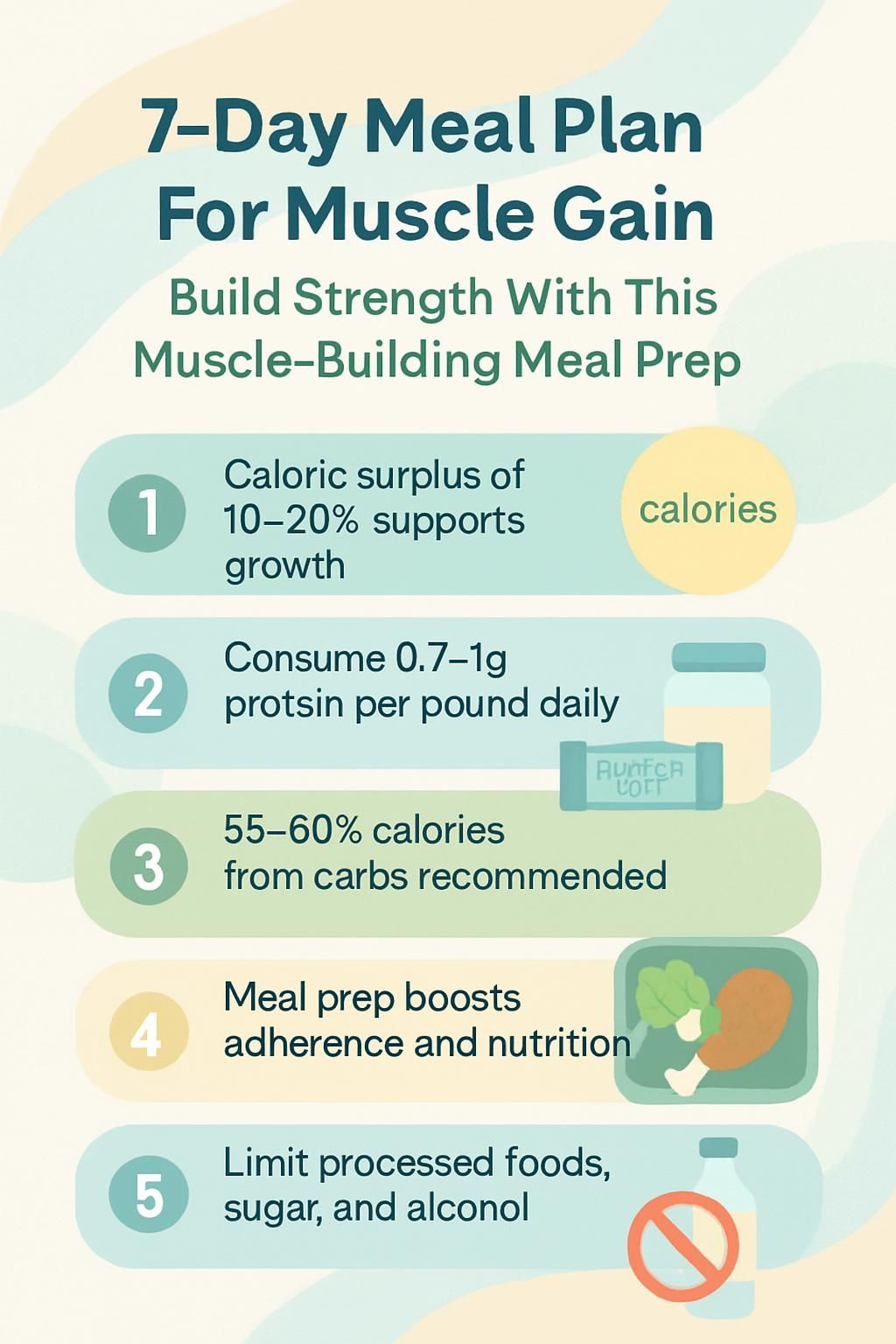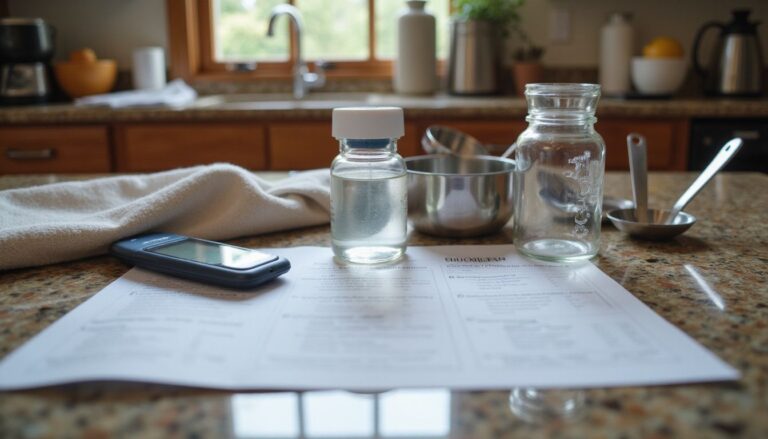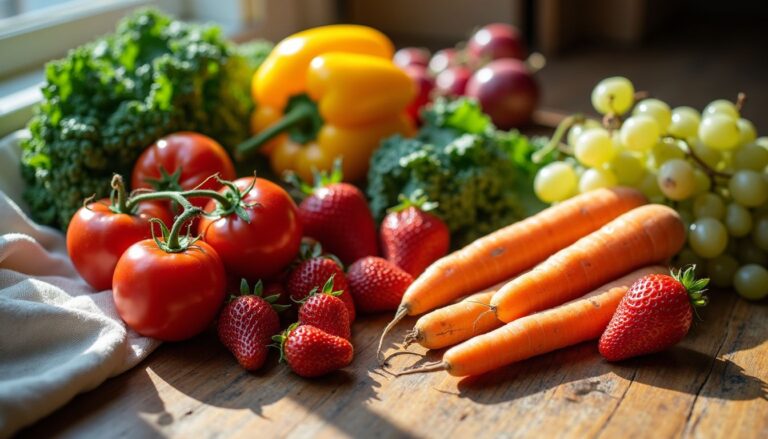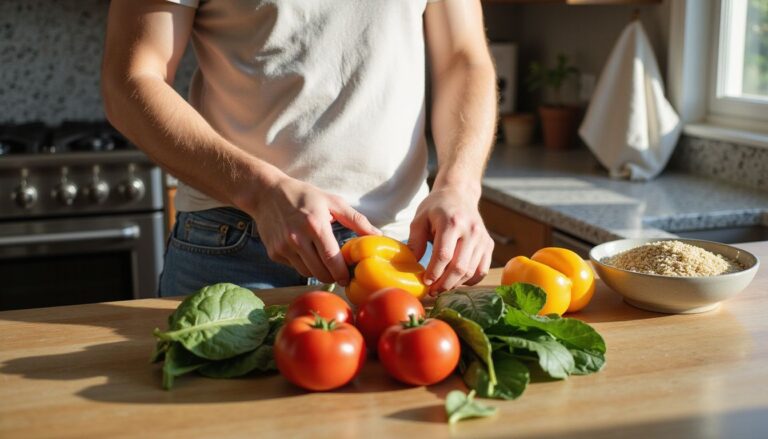7-Day Meal Plan For Muscle Gain: Build Strength With This Muscle-Building Meal Prep
Our Nutrition Assistant AI Suite will transform your body. You will lose fat, get toned, and build muscle. Gain confidence and optimal health.
You want to build strength and add lean muscle, yet the daily eating part can feel confusing. A clear meal plan for muscle gain removes the guesswork and gives your training steady support. With the right calories, protein, carbohydrates, and healthy fats, your body repairs faster and grows stronger between workouts.
This practical guide gives you a 7-day meal plan with simple meals and snacks. You will find easy meal prep steps that fit busy weeks, plus tips to personalize your plan. Start with the basics and you can turn consistent choices into visible progress.
Key Takeaways
- A modest caloric surplus, about 10 to 20 percent above maintenance, plus 0.7 to 1 gram of protein per pound of body weight supports muscle gain.
- Research suggests 1.6 to 3.1 grams of protein per kilogram per day, spread evenly across meals, to maximize muscle protein synthesis and recovery.
- A balanced plan often includes 55 to 60 percent of calories from carbohydrates and 15 to 20 percent from healthy fats to fuel training and hormones.
- Planning meals ahead improves adherence, portion control, and micronutrient intake; it also cuts food waste and supports steady muscle growth.
- Limiting ultra-processed foods, sugary drinks, and alcohol helps reduce unwanted fat gain and improves muscle-building outcomes.

Why Is Meal Prepping Important for Muscle Growth?

Meal prepping helps you hit daily calorie and macro targets with less stress. Macros, short for macronutrients, are protein, carbohydrates, and fats. Many sports dietitians recommend 0.7 to 1 gram of protein per pound of body weight to build muscle efficiently.
Cooking in batches makes it easy to eat enough high quality protein with rice, potato, and vegetables on busy days. Preparing chicken, lean beef, or tofu at once saves time all week. Using portioned containers keeps carbs and fats organized for quick meals after training or during lunch.
Planning ahead is my go-to strategy,
notes a registered dietitian with the International Society of Sports Nutrition. Buying staples in bulk lowers cost and cuts food waste. These habits make a consistent muscle-building diet easier to follow month after month.
Nutrition Strategies for Muscle Building
Smart prep paired with the right nutrition strategies speeds growth and supports recovery. Set clear macronutrient targets so you can build strength and keep energy steady all day.
What Is a Caloric Surplus and Why Does It Matter?
A caloric surplus means eating more calories than your body needs to maintain weight. That extra energy fuels muscle protein synthesis, the process that repairs and builds muscle tissue after training.
Most research supports a 10 to 20 percent surplus. If maintenance is 3,000 calories per day, aim for 3,300 to 3,600 calories during a build phase. As an example, a 150 pound person might target roughly 2,200 to 2,600 calories, then adjust based on weekly results.
Track weight three times per week and log your intake in an app. Aim to gain about 0.5 to 1 percent of body weight per week. That pace supports lean tissue gains from resistance training while keeping fat gain in check. Review and adjust monthly as your metabolism and training change.
How Much Protein Do You Need to Build Muscle?
Protein is the key building block for muscle growth and repair. Aim for 1.6 to 3.1 grams per kilogram of body weight per day. If you weigh 150 pounds, that equals about 105 to 210 grams daily. Many lifters set protein near 30 to 35 percent of total calories.
For example, at 3,450 calories, a common target range is 259 to 302 grams. At 2,550 calories, 191 to 223 grams fits many plans. Choose high quality sources such as chicken, eggs, salmon, whey protein powder, Greek yogurt, beans, and tofu at every meal or snack.
To support muscle hypertrophy, spread protein across breakfast, lunch, dinner, and snacks to keep amino acids available.
Studies show that even distribution increases muscle repair throughout the day. A steady protein pattern works better than loading all protein at one meal.
Why Are Carbohydrates and Fats Essential for Energy and Recovery?
Carbohydrates and fats power training and help muscles recover. Carbs provide 4 calories per gram and refill muscle glycogen, the fuel stored in muscle. Many athletes do well with 55 to 60 percent of calories from carbs such as oats, brown rice, pasta, and potatoes.
On a 3,450 calorie plan, that equals about 474 to 518 grams of carbs. At 2,550 calories, it is roughly 351 to 383 grams. Healthy fats provide 9 calories per gram and support hormones like testosterone that aid repair. Many plans aim for 15 to 20 percent of calories from fats such as olive oil, avocado, nuts, and seeds.
Enough dietary fat also improves vitamin absorption and helps you maintain energy across long days of training.
When Should You Eat Meals and Snacks for Best Results?
Eat every 3 to 4 hours to support muscle protein synthesis and steady energy. This schedule helps maintain a flow of amino acids for repair. After workouts, eat 20 to 30 grams of protein with moderate carbs to speed recovery and refill glycogen.
Include a protein source in each meal or snack. Hydrate well too, about 13 cups per day for men and about 9 cups for women. Consistent timing makes it easier to gain muscle mass, power workouts, and manage hunger.
Best Foods to Include in a Muscle-Building Diet
The right foods give you the raw materials to grow. Start with quality protein, then add complex carbs, healthy fats, and colorful vegetables.
What Are the Top High-Protein Foods for Muscle Gain?
Protein-rich foods supply the amino acids your muscles need to repair and grow.
- Chicken breast has about 31 grams of protein per small piece; grill or roast for easy prep.
- Whey protein isolate provides about 20 to 25 grams per scoop; blend into shakes for quick protein after training.
- Cottage cheese offers about 23 grams per cup and pairs well with fruit for a simple snack.
- Shrimp delivers about 20 grams per 3 ounces and cooks fast for salads or stir-fries.
- Greek yogurt packs about 20 grams per 7 ounces plus gut-friendly probiotics.
- Tempeh supplies about 20 grams per 100 grams and adds fiber for plant-based meals.
- Canned salmon has about 20 grams per 3 ounces and includes omega-3 fats for recovery.
- Lentils provide about 18 grams per cup plus iron and slow-digesting carbs.
Include one of these at each meal to meet your daily protein goal and support growth.
Which Carbohydrates Provide Long-Lasting Energy?
Complex carbohydrates deliver steady energy for training and recovery. They also provide fiber, vitamins, and minerals.
- Oats are rich in fiber and protein, great for breakfast or pre-workout fuel.
- Quinoa is gluten free and offers protein, minerals, and carbs for recovery.
- Brown rice brings slow-digesting carbs and B vitamins for energy production.
- Sweet potatoes offer potassium and complex carbs, ideal post workout.
- Lentils add fiber, plant protein, and iron for sustained activity.
- Black beans give protein and slow-release carbs that support heart health.
- Barley contains soluble fiber that steadies energy for hours.
- Buckwheat offers antioxidants and works for savory bowls or hot cereal.
- Kidney beans help refill glycogen stores after tough training.
Mix several sources across the week so your meals stay interesting and well balanced.
What Healthy Fats Should You Eat for Muscle Growth?
Healthy fats support hormones, help absorb nutrients, and add calories for a controlled surplus.
- Avocados provide monounsaturated fat that supports recovery and heart health.
- Olive oil or avocado oil boosts nutrient absorption in salads and roasted vegetables.
- Almonds and walnuts add minerals like magnesium along with protein and calories.
- Flax, chia, and sunflower seeds supply omega-3 fats that calm training inflammation.
- Greek yogurt or cottage cheese adds fat plus protein in one serving.
- Whole eggs include yolks that carry vitamins and support hormone production.
- Nut butters like almond butter add flavor and keep you full between meals.
Include a small portion of fat in each meal for better energy and satisfaction.
Which Vegetables and Greens Are Best for Micronutrients?
Vegetables and leafy greens supply vitamins, minerals, and fiber that your muscles and immune system need.
- Broccoli provides vitamin C, vitamin K, and folate; one cup cooked covers your daily vitamin C needs.
- Spinach or kale deliver iron, magnesium, and potassium that support muscle function.
- Tomatoes add lycopene, vitamin C, and potassium that aid hydration.
- Green beans supply vitamin K, manganese, and fiber for digestive health.
- Cucumbers are high in water and add crunch with very few calories.
- Zucchini is low calorie and high in vitamin A for skin repair.
- Asparagus brings folate and vitamins E and K that support recovery.
- Bell peppers deliver high vitamin C and bright color for antioxidant support.
- Mushrooms provide B vitamins that help the body turn food into energy.
Build meals around protein first, then add two colorful vegetables for a nutrient boost.
Which Foods Should You Limit for Better Muscle Growth?
Choosing what to limit can protect your progress. Think of this as clearing roadblocks from your path.
Why Avoid Processed and Sugary Foods?
Ultra-processed foods like candy, cookies, doughnuts, ice cream, fast food, and packaged snacks bring lots of calories with very few nutrients. They add sugar and refined oils, which make it harder to hit protein and micronutrient goals.
Reviews show diets high in added sugar can raise blood sugar swings and increase risk of fatty liver disease and heart disease. Swapping packaged items for whole foods improves strength sessions and body composition.
How Do Sugary Drinks and Snacks Affect Muscle Gain?
Sodas and energy drinks add empty calories without protein or key minerals. High added sugar raises LDL, the bad cholesterol, and raises long-term risk for chronic disease. Energy drinks can spike blood pressure and then leave you crashing later.
Frequent sugary snacks keep blood sugar unstable, which can stall gains. Whole foods give better fuel for training and recovery.
What Are the Effects of Alcohol on Muscle Building?
Alcohol slows the rate at which your body builds new muscle proteins after exercise. Regular heavy intake can also delay recovery and increase fat gain. Studies report added risks for liver problems and lower training performance.
Alcohol can hurt sleep and hydration too, both important for muscle repair. If building muscle is a top goal, limit or avoid alcohol for faster progress.
Sample 7-Day Muscle Gain Meal Plan
This seven day plan shows you how to reach calorie and protein targets while keeping meals simple. Adjust portions based on your maintenance level and activity.
What Does a Protein-Packed Day 1 Look Like?
Breakfast: scrambled eggs, whole grain toast, and Greek yogurt for about 30 grams of protein. Morning snack: cottage cheese with almonds or a boiled egg to raise protein further.
Lunch: grilled chicken breast with brown rice, steamed broccoli, and olive oil, roughly 45 grams of protein plus minerals. Afternoon snack: low fat string cheese with fresh fruit.
Dinner: baked salmon with quinoa and roasted sweet potatoes. Total intake lands near 2,401 calories for many people. A final snack of plain Greek yogurt with berries provides slow digesting casein before bed.
How to Start Day 2 with a Protein Shake and Healthy Meals?
Breakfast: a whey isolate shake for about 25 grams of quick protein. Add a banana or oats for fast carbs before a morning workout.
Lunch: grilled chicken breast with brown rice and broccoli. Snacks: Greek yogurt or cottage cheese with sliced almonds for protein and minerals. Include olive oil or avocado at meals to aid recovery and add healthy fats.
What Are Balanced Meal Ideas for Day 3?
Focus on balance at each meal, combining lean protein, complex carbs, and healthy fats. Breakfast: eggs cooked in olive oil with whole grain toast and fresh tomato. This mix hits roughly 33 percent protein, 55 percent carbs, and 17 percent fat by calories.
Lunch: grilled chicken with brown rice and steamed broccoli. Use salsa or a light teriyaki for flavor without excess sugar. A typical serving brings about 35 grams of protein and steady carbs for afternoon training.
Dinner: salmon baked in foil with lemon, served with sweet potato mash and sautéed spinach. Salmon provides protein and healthy fats that support hormone balance during hard training.
Snacks: Greek yogurt with berries or cottage cheese with sliced banana. Spreading protein across the day keeps amino acids available for muscle repair. Research supports even protein distribution for better gains [1]. Creatine can help performance, yet whole foods should come first [2].
[1] Areta JL et al., J Physiol, 2013. [2] Kreider RB et al., J Int Soc Sports Nutr, 2017.
How to Include Dairy and Protein-Rich Foods on Day 4?
Breakfast: Greek yogurt with sliced fruit or a handful of oats, about 20 grams of protein. Lunch or snack: cottage cheese as a veggie dip or on whole grain toast, about 23 grams per cup.
Add low fat milk in smoothies or enjoy it with meals to increase calcium and protein. Dinner: grill lean chicken breast with steamed broccoli and a light sprinkle of shredded cheese for taste and extra nutrients.
What Is a Muscle-Building Breakfast with Oats and Nut Butter on Day 5?
Cook one cup of oats and stir in two tablespoons of nut butter. Oats bring complex carbs that refill glycogen after morning training. Nut butter adds healthy fats and extra protein.
Peanut butter gives about 8 grams per two tablespoons. Almond butter gives about 7 grams. Add sliced banana or a drizzle of honey for flavor. Expect roughly 350 to 400 calories and around 15 grams of plant protein.
How to Make Protein Pancakes and Flavorful Meals on Day 6?
Stir one scoop of whey or plant protein powder with oats, eggs, and milk to make a thick batter. Cook on a nonstick skillet until both sides are golden. Top with nut butter, fresh berries, or cinnamon for variety.
For lunch or dinner, grill chicken or salmon and pair with sweet potatoes and leafy greens. Use spices such as garlic powder, paprika, or black pepper to keep flavors fresh while keeping calories in check.
Protein Content in Pancakes (per serving)
| Ingredient | Protein (g) |
|---|---|
| Whey or Plant Protein Powder | 20 to 25 |
| Eggs | 12 |
| Oats | 5 |
Rotating seasonings and toppings reduces taste fatigue and improves adherence to your plan.
…
Sources:
- J Int Soc Sports Nutr, 2017, Dietary protein intake and human health.
- Harvard Health Publishing, grilling tips.
- Meal prep experience from weekly strength cycles.
What Are Energizing Egg and Greens Meals for Day 7?
Eggs offer about 6 grams of protein per large egg and support muscle growth. Scramble or poach eggs and serve over spinach or kale for vitamins A, C, and K plus iron and magnesium.
Add bell peppers for color, crunch, and vitamin C. Hard boil eggs and slice them over a mixed greens bowl for a fast, high protein lunch. Whole food meals like these support satiety and steady energy through the day.
Tips for Efficient Muscle-Building Meal Prep
Small systems make meal prep easier. Build a routine that fits your week and stick with it.
How to Batch Cook Proteins and Carbs Efficiently?
Cook protein in bulk once or twice a week. Bake several chicken breasts, boil eggs, and prepare tofu or canned tuna for fast meals. Studies show that prepping protein ahead helps you meet daily protein goals.
For carbs, cook big batches of brown rice, oats, or sweet potatoes. Store them in portioned containers so you can assemble plates quickly after training.
What Are the Best Ways to Organize Meals with Portioned Containers?
Use BPA free containers to keep food fresh. Label each container with the meal and day. Clear labels reduce guessing and support your plan.
Divide proteins, carbs, and vegetables in separate sections to control portions. Stack containers by day of the week in your fridge for an easy grab and go system.
How Can You Rotate Flavors to Keep Meals Exciting?
Vary spices, herbs, and low calorie sauces each week. Try cumin and smoked paprika for a Mexican style chicken. Use ginger and soy sauce for an Asian style turkey bowl. Flavor rotations help cut taste fatigue over time.
Change protein sources through the week. Mix chicken, lean beef, tofu, and salmon. Swap carb bases too, such as sweet potatoes early, then brown rice or whole grain pasta later.
Why Focus on Post-Workout Nutrition?
Your body absorbs nutrients best during the first hour after training. A post workout meal with 20 to 30 grams of protein and a moderate amount of carbs supports repair and reduces soreness.
Planning this meal in advance helps you refuel fast. Many lifters notice better next day energy once they add a simple protein and carb combo after lifting.
Supplements That Support Muscle Growth
Supplements can help, yet they work best on top of a solid diet. Review the evidence and pick options that match your goals.
How Does Protein Powder Enhance Muscle Building?
Whey protein powder makes it easy to increase daily protein intake. A scoop typically adds 20 to 25 grams of complete protein, which helps meet targets set by sports nutrition guidelines.
Add a scoop to smoothies, oatmeal, or a post workout shake. This simple step supports faster recovery and stronger muscles without much prep time.
What Are the Benefits of Creatine for Performance?
Creatine monohydrate increases stored energy in muscles, called phosphocreatine. Research shows it can improve high intensity performance by about 8 percent.
You may recover faster between sets and lift more total weight. Creatine supports gains in strength and lean mass when paired with resistance training and a controlled surplus.
How Do BCAAs Help with Recovery?
Branched chain amino acids, or BCAAs, can reduce muscle breakdown and soreness after tough sessions. A 2017 trial found less muscle damage when people took BCAAs before exercise compared to a placebo.
If your total daily protein is already high, benefits may be smaller. Still, some athletes find BCAAs useful during intense training weeks.
Why Take Multivitamins for Overall Health?
Even with careful prep, you might miss key micronutrients like vitamin D, magnesium, or zinc. A daily multivitamin can help cover small gaps while you focus on training and recovery.
Balanced nutrient levels support immune function, energy, and muscle repair across long programs.
How to Overcome Common Meal Prep Challenges
Challenges happen, especially during busy weeks. A simple plan helps you stay on track.
How to Stay Consistent with Meal Prepping?
Pick a regular prep time that fits your life, such as Sunday afternoon or two weeknights. Use portioned containers to make meals easy to grab. If full week prep feels hard, start with lunches and dinners only.
Rotate recipes if you get bored. Swap chicken for lean beef or beans. A small change in sauce or spices can keep you engaged while hitting calorie goals.
What Are Effective Ways to Manage Unhealthy Food Cravings?
Cravings often drop when you eat enough protein at each meal. Higher protein intake has been linked to fewer late night snacks. Add Greek yogurt or chicken breast to meals to increase fullness.
Stay hydrated since thirst can feel like hunger. Flavor water with lemon or berries if needed. Many people reduce snack intake once they drink more water across the day.
How Can You Customize Your Meal Plan for Better Results?
Adjust portions to match your goals. If you need a larger surplus, add a protein rich snack such as yogurt with almonds. Many lifters grow well with 250 to 500 extra calories per day compared to maintenance.
Plant based eaters can hit protein goals using tofu, tempeh, lentils, and seitan. Research shows well planned plant based diets can support similar muscle gains as animal focused diets when total protein is adequate.
What Are the Key Benefits of Following a Muscle-Building Meal Plan?
A structured plan helps you meet nutrition needs, track progress, and stay motivated. Clear targets turn hard training into steady results.
How Does It Help Build Muscle Strength and Mass?
A caloric surplus paired with a protein rich diet improves training capacity and recovery. Studies show that combining resistance training with higher daily protein increases muscle mass and strength.
Balanced meals across the day keep energy high for intense lifts. Carbs refill glycogen while fats support hormones needed for growth.
In What Ways Does It Boost Energy for Workouts?
Carbohydrates are your main training fuel. Many lifters thrive on 3.5 to 5 grams of carbs per kilogram of body weight per day during build phases. Whole grains, fruit, rice, and potatoes release energy slowly so you can keep pushing.
Hydration also matters. Aim for about 13 cups of water daily if you are a man and about 9 cups if you are a woman. Good hydration supports stamina and reduces cramps.
How Does It Speed Up Recovery After Exercise?
Eating 20 to 30 grams of protein with carbohydrates within an hour after training speeds repair. This combination increases protein synthesis so muscles rebuild stronger.
Whole foods rich in vitamins and minerals also support your immune system during hard blocks of training and can reduce soreness.
Conclusion
Following a clear muscle-building meal plan helps you hit calorie and protein targets, fuel workouts, and recover well. With steady prep and simple food choices, you can build strength, add muscle, and feel more in control of your progress.
This information is for education, not medical advice. If you have a health condition or special dietary needs, consult a registered dietitian or your healthcare provider to tailor the plan to you.
FAQs
1. What is the main goal of a 7-day meal plan for muscle gain?
A 7-day meal plan for muscle gain aims to help individuals build strength and increase lean body mass. The plan uses evidence from peer-reviewed studies to guide food choices that support muscle growth.
2. How do peer-reviewed studies support this muscle-building meal prep?
Peer-reviewed studies provide data on optimal protein intake, calorie needs, and nutrient timing for building muscle. These sources confirm that eating enough protein with each meal helps repair and grow muscles after exercise.
3. Can you share an example of how this meal plan works in real life?
After following a structured 7-day meal plan based on scientific research, many people notice improved energy during workouts and faster recovery times. For instance, I once used such a plan before a sports event; my performance improved as I felt stronger throughout the week.
4. What are some key nutrients included in this evidence-based approach?
The most important nutrients include high-quality proteins like poultry or fish, complex carbohydrates such as brown rice or oats, healthy fats from nuts or olive oil, and plenty of vegetables for vitamins and minerals. Peer-reviewed studies show these foods work together to promote steady gains in strength while supporting overall health.
Summary:
A well-designed 7-day meal plan for muscle gain relies on credible research to select foods that boost strength efficiently. Using findings from peer-reviewed studies ensures each part of the diet supports your fitness goals with proven results.







